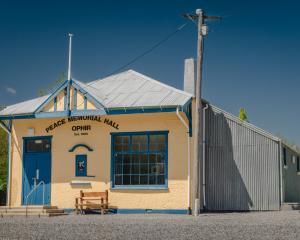As the world enters a more environmentally-aware era, sustainable building resources are back in vogue. Catherine Pattison talks to two Lake Hawea brothers, who realised long before it was fashionable that they really dug dirt and were so captivated by it as a construction material that they have both built houses out of this natural resource.
Two Lake Hawea brothers have been so captivated by earth as a building material they have both constructed houses out of this abundantly available natural resource.
While Jimmy Cotter (44) has taken it a step further and made rammed-earth houses his livelihood, his older sibling Mike (53) is happy just to live within its energy-efficient walls.
The path to building his four-bedroom earth home, began back in the mid-1980s when he and wife Michelle bought a "dilapidated", old, earth shepherd's cottage in nearby Hawea Flat. A plan to replicate it on a larger scale was hatched "just living in that, with the earth being so cool in the summer and so warm in the winter."
In 2001, after 11 years running the family-owned Lake Hawea Holiday Park, he built their new home, looking down towards Bendigo Valley, using a mixture of timber framing and rammed earth, with help from Jimmy and a couple of labourers.
Incorporating Oregon milled from the holiday park meant the bond beams are sturdy reminders of their time there and similarly obtained eucalyptus doors and benchtops are also features in Jimmy and his wife Rebecca's three-bedroom earth-brick home, high on the hills overlooking Lake Hawea.
While some locations have the right soil blend on site for people to incorporate their own land in their living abode, the Cotter brothers have access to the close-by Cardrona valley earth. It contains a virtually ready-to-go combination - one third each of clay, gravel and sand.
The rocks are screened out, a small amount of cement, plus exactly the right amount of water is added, then an extensive testing process ensues to ensure the earth is going to make a suitable habitat.
"You don't want your house smelling like a peat bog or an outside toilet," Mike says, laughing.
Positioning earth homes to work in harmony with the seasons is vital and his has been constructed with this in mind.
In winter the sun radiates through the eaves and windows letting its warmth into the walls, allowing the thermal mass to build up and create passive heating.
Come summer time the sun shines more directly overhead, when the roof insulation resists its heat, ensuring the walls and house stay cool.
Built with two living rooms, to allow space for his four children as they grew up, the ample ambience of his earth home is now enjoyed by Mike and Michelle's two grandchildren when they visit.
"I hold the passion for it and certainly if I build another house it would be earth," Mike says.
Jimmy has taken this desire for a sustainable and chemical-free dwelling and turned it into his day job. After starting out as a conventional builder, he made the switch to doing it with dirt 17 years ago and set up Down to Earth Building.
Since then he has constructed 40 rammed earth wineries, lodges, residential single and two-storeyed homes and commercial premises all around Central Otago - with Wanaka vineyard Rippon's new tasting room and vaulted hall one of his most recent projects.
Rammed-earth houses are built in a surprisingly quick process. Plywood formwork is set up in modules that will constrain walls about 450mm thick as they are formed. Jimmy gets inside the wall formwork, with the powerful, piston air-rammer, which he describes jokingly as a "big, horrible weapon".
As the earth mixture is shovelled in from above, he densely compacts it, layer by layer. Although it is not work suitable for claustrophobics or those afraid of hard labour, the end result is worth a certain amount of grime and discomfort.
"It's really quite therapeutic. You come out and strip away the frames and that wall is there forever," Jimmy says.
It is also a low-maintenance material, with no need of paint, insulation or gib-stopping. With some pre-planning, the creative licence is endless.
"There are no boundaries. Whatever you want, you can create." Recessed bookshelves, inset wine racks, and niches to house nick nacks, art or shelving can be catered for.
However, Jimmy cautions that you can get funky or stay extremely simple with your designs, but once it is rammed there is no going back.
"With earth you have to have a lot of thought, because you can't move a wall or even a light socket."
Rammed-earth houses might cost about 5% more than a basic conventional house but it's money well spent, according to Jimmy.
"With earth, you get that feel-good feel."












